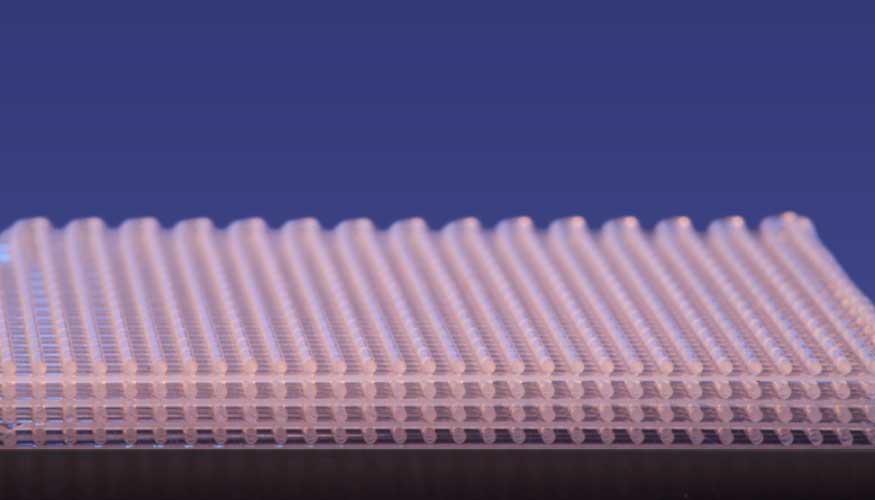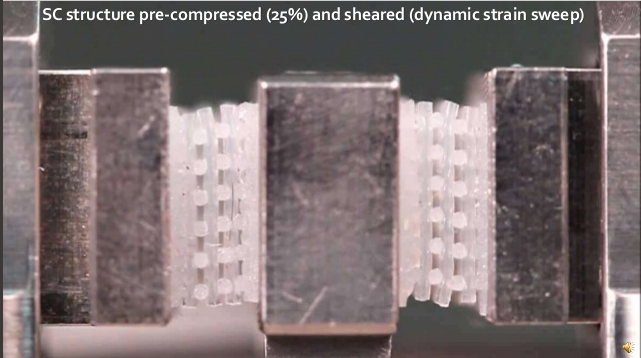Cushioning or padding are utilized to dampen shock and vibrations, distribute and relieve stress, maintain relative positioning, or mitigate the effect of size variation. The materials that serve these purposes are part of our ever day lives in sporting and other consumer goods, as well as being utilized by the defense and aerospace industries and for packaging and transportation. Their ubiquitous nature has led to a thorough study of their uses, characteristics, strengths, and weaknesses.
This cushioning and padding can be provided through either gels or foams but either method has its disadvantages. Gels provide a high level of cushioning but are subject to lower performance depending on the temperature, and they are relatively heavy. In contrast, foams are lighter and have a high level of compressibility but their performance varies unpredictably as it is not possible to entirely control the shape, size, or placement of the air pockets they contain.
 In an attempt to create a better product, engineers and scientists at Lawrence Livermore National Laboratory (LLNL) worked together to create an entirely new way of producing a cushioning material. Their approach was to work at the microscale and fabricate a material with a number of programmable properties that could be manipulated to create the desired characteristics.
In an attempt to create a better product, engineers and scientists at Lawrence Livermore National Laboratory (LLNL) worked together to create an entirely new way of producing a cushioning material. Their approach was to work at the microscale and fabricate a material with a number of programmable properties that could be manipulated to create the desired characteristics.
These new materials are produced using an additive manufacturing techniques called direct ink writing with a silicone-based ink that cures into a material much like rubber. Using this technique, engineers at LLNL are able to create materials with controlled, complex architectures called cellular elastomers. These ordered, cellular materials enable improved control over the material’s mechanical and directional properties, enhanced uniformity, and increased predictive modeling capability.
The team has released their research in the Journal of Advanced Functional Materials. Lead author Eric Duoss described the nature of their contribution:
“The ability to dial in a predetermined set of behaviors across a material at this resolution is unique, and it offers industry a level of customization that has not been seen before.”
The cushion material that the LLNL researchers created can have one of two different forms, a stacked inline configuration or a staggered configuration. The component materials for either configuration are exactly the same and posess the same degree of porosity but they exhibit very different responses to shear and compression stresses. The stacked configuration undergoes a buckling instability under increased compression, but at normal compression exhibits a stiffer structure while the staggered material is softer under normal compression with a bending deformation under increased compression.
 Currently, LLNL has patents filed for the materials they have engineered and are working to scale up their infrastructure to allow for commercial production. In addition, they are hoping to continue refining and improving the product as well as seeking out additional performance characteristics that make it suitable for a wider variety of market applications.
Currently, LLNL has patents filed for the materials they have engineered and are working to scale up their infrastructure to allow for commercial production. In addition, they are hoping to continue refining and improving the product as well as seeking out additional performance characteristics that make it suitable for a wider variety of market applications.
Subscribe to Our Email Newsletter
Stay up-to-date on all the latest news from the 3D printing industry and receive information and offers from third party vendors.
Print Services
Upload your 3D Models and get them printed quickly and efficiently.
You May Also Like
Metal Powder Supplier Elementum 3D Added to $46B Air Force Contract
Elementum 3D, a Colorado-based developer and supplier of metal powders used in additive manufacturing (AM), announced that the company has been added to the vendors list in the fourth on-ramp...
Ursa Major Lands $28.6M AFRL Deal for 3D Printed Draper Engine Flight Demo
The US Air Force Research Laboratory’s (AFRL’s) Rocket Propulsion Division at Edwards Air Force Base has awarded a $28.6 million contract to Ursa Major for follow-on work related to the...
3D Printing Financials: Rocket Lab’s Record-Breaking Year and Over 20 Launches Coming in 2025
Rocket Lab (Nasdaq: RKLB) closed 2024 with its best year yet. The company launched more rockets, signed more contracts, and expanded deeper into spacecraft and satellite production than ever before....
US Air Force Taps Beehive to Study 3D Printed Jet Engines
Propulsion 3D printing firm Beehive Industries secured a contract from the U.S. Air Force Life Cycle Management Center through SOSSEC. SOSSEC is a company that manages Other Transactions Authority (OTA)...

































